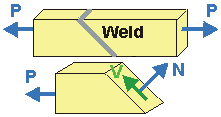|
» Principal Stresses
PRINCIPAL STRESSES are
the Maximum and Minimum Normal Stresses that occur at a
point as the set of axes is rotated by angle q.
The Principal Stresses are called sI
and sII,
and occur along the xp-yp axes. The Principal
Stresses for a given stress state are given by:
|
sI
=
|
sx
+ sy

2
|
+
|
|
|
sx
 sy sy

2
|
|
2
|
+ txy2
|
|
1/2
|
|
sII
=
|
sx
+ sy

2
|
-
|
|
|
sx
 sy sy

2
|
|
2
|
+ txy2
|
|
1/2
|
|
The larger of the two stresses is generally termed sI.
- The Principal Stresses occur when the stress element has been rotated
by an angle of qp, where:
|
tan(2qp)
=
|
2txy

sx - sy
|
|
This equation has two results: angles, qpI
and qpII, (90° apart).
It is not always obvious which angle goes with which Principal Stress.
It is often best to substitute one of principal angles into the general
stress-transformation equation for sx'(qp).
By doing so, the appropriate angle is matched with the right stress.
- KEY POINT: When the Normal Stresses are Principal Stresses
the Shear Stress is Zero. This can be shown by plugging in either
of the principal angles into the general equation for. tx'y'(qp)
|











